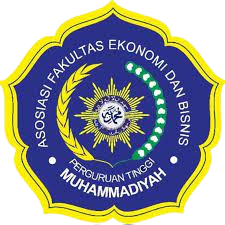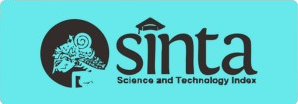Banking Profitability Analysis: Company Cases on the Stock Exchange Indonesian Securities (BEI)
DOI:
https://doi.org/10.24269/ekuilibrium.v19i1.2024.pp73-91Abstract
This study aims to investigate the impact of Loans to Deposit Ratio (LDR) on Return On Assets (ROA) in the context of banking institutions. LDR is used as an indicator of a bank's ability to meet obligations and credit demands, while ROA reflects the level of bank profitability. The signal theory is also adopted to explain the asymmetry of information between company management and other stakeholders. The data used in this study was obtained from banking institutions with sample consists of 25 banking companies listed on BEI during the 2016-2019 period. The results indicate that LDR has a significant impact on ROA. Higher LDR values indicate a larger amount of third-party funds channeled into credit, which in turn increases profitability through higher interest income. These findings are consistent with previous research indicating a positive relationship between LDR and ROA. The results of this study contribute to the understanding of factors influencing the financial performance of banking institutions. Banking practitioners and investors can use these findings as a basis for making better decisions in managing risks and enhancing profitability.
References
Anggraini, A. (2019). Pengaruh Penerapan Manajemen Risiko Terhadap Kinerja Bank Pembiayaan Rakyat Syariah (BPRS)(Studi Pada BPRS Se-Kota Bandar Lampung) (Doctoral dissertation, UIN Raden Intan Lampung).
Akhtar, M. F., Ali, K., & Sadaqat, S. (2011). Factors influencing the profitability of Islamic banks of Pakistan. International research journal of finance and economics, 66(66), 1-8.
Almilia, L. S., & Utomo, A. W. (2006). Faktor-Faktor Yang Mempengaruhi Tingkat Suku Bunga Deposito Berjangka Pada Bank Umum Di Indonesia. Jurnal Ekonomi dan Bisnis ANTISIPASI, 10(1), 11.
Ambo Aman (2013). Analisis Kinerja Keuangan Dengan Menggunakan Metode CAMEL pada Bank Umum Swasta Nasional Devisa di Indonesia tahun 2007-2011, Skripsi Jurusan Manajemen Fakultas Ekonomi dan Bisnis Universitas Hasanudin, Makasar.
Annisa, A. (2018). Analisis Pengaruh Risiko Perbankan Terhadap Kinerja Keuangan (Pada Perbankan yang Terdaftar di Bursa Efek Indonesia).
Antonio, M. S. I. (2001). Bank Syariah: dari teori ke praktik. Gema Insani..
Arindi, G. P., & Mawardi, W. (2016). Analisis Pengaruh Risiko Kredit, Intermediasi Perbankan, Risiko Likuiditas, Dan Efisiensi Manajemen Terhadap Profitabilitas Perbankan Indonesia (Studi Kasus pada Bank Umum Konvensional yang Terdaftar di Bursa Efek Indonesia Periode 2010-2014). Diponegoro Journal of Management, 5(3), 490-502.
Arini, E. V. (2017). Pengaruh Risiko Usaha Terhadap Profitabilitas Pada Bank Umum Swasta Nasional Devisa (Doctoral dissertation, STIE Perbanas Surabaya).
Arthesa, A., & Handiman, E. (2006). Bank dan lembaga keuangan bukan Bank. Jakarta, PT Indeks Kelompok Gramedia.
Brigham, E. F., & Houston, J. F. (2010). Dasar-Dasar Manajemen Keuangan (Edisi 11). Jakarta: Salemba Empat.
Brigham, E. F., & Houston, J. F. (2006). Dasar-dasar manajemen keuangan.
Cahyani, N. K. (2013). Pengaruh Risiko Usaha terhadap Return On Asset (ROA) pada Bank Umum Swasta Nasional Devisa (Doctoral dissertation, STIE Perbanas Surabaya)..
Chapra, M. U. (2000). Islam dan tantangan ekonomi. Gema Insani.
Damayanti, P. (2012). Analisis pengaruh ukuran (size), CAR, pertumbuhan deposit, LDR, terhadap Profitabilitas Perbankan Go Public di Indonesia tahun 2005-2009. Jurnal Imu Manajemen dan Akuntansi Terapan, 3(2).
Fahmi, I. (2012). Analisis kinerja keuangan: panduan bagi akademisi, manajer, dan investor untuk menilai dan menganalisis bisnis dari aspek keuangan.
Fatmawati, I. (2015). Pengaruh Risiko Likuiditas, Risiko Kredit, Risiko Pasar, Dan Risiko Operasional Terhadap Roa Bank Go Public (Doctoral dissertation, STIE PERBANAS SURABAYA).
Ghozali, I. (2018). Aplikasi Analisis Multivariative Dengan Program IBM SPSS 25 Edisi 9. Badan Penerbit Universitas Diponegoro.
Greuning, H. V., & Bratanovic, S. B. (2011). Analisis Risiko Perbankan. Jakarta: Salemba Empat.
Haneef, S., Riaz, T., Ramzan, M., Rana, M. A., Ishaq, H. M., & Karim, Y. (2012). Impact of risk management on non-performing loans and profitability of banking sector of Pakistan. International Journal of Business and Social Science, 3(7), 307-315.
Herman, D. (2011). Manajemen Perbankan, edisi keempat. Jakarta: Penerbit Bumi Aksara.
Julita, I. (2013). Pengaruh Likuiditas terhadap Profitabilitas pada Sektor Perbankan yang Terdaftar di Bursa Efek Indonesia (BEI). Jurnal Manajemen, 2(01).
Kasmir, S. E. (2010). MM, 2000. Manajemen Perbankan, PT. Raja Grafindo Persada, Jakarta. Kasmir. 2003. Bank Dan Lembaga Keuangan lainnya. Jakarta: PT Raja Grafindo Persada. prof. Dr. Hj. Umi Narimawati, Dra., SE., M., Si, Sri Dewi Anggadini, SE., M. Si, Linna Ismawati, SE., M. Si.
Kasmir, B., & Lainnya, L. K. (2004). Jakarta: Rajawali Pers, 2013. Manajemen Perbankan, Jakarta: PT. Raja Grafindo Persada.
Kolapo, T. F., Ayeni, R. K., & Oke, M. O. (2012). Credit Risk And Commercial Banks'performance In Nigeria: A Panel Model Approach. Australian journal of business and management research, 2(2), 31.
Lukman, D. (2009). Manajemen Perbankan. Jakarta: Ghalia Indonesia.
Mahmoeddin, A. (2002). Melacak kredit bermasalah. Pustaka Sinar Harapan.
Manikam, J., & Syafruddin, M. (2013). Analisis Pengaruh Capital Adequacy Ratio (CAR), Net Interest Margin (NIM), Loan To Deposit Ratio (LDR), Non Performing Loan (NPL) dan BOPO terhadap Profitabilitas Bank Persero di Indonesia Periode 2005-2012. Diponegoro Journal Of Accounting, 380-389.
Martono, S. U. (2007). Bank dan Lembaga Keuangan Lainnya.
Mosey, A. C., Tommy, P., & Untu, V. N. (2018). Pengaruh Risiko Pasar Dan Risiko Kredit Terhadap Profitabilitas Pada Bank Umum Bumn Yang Terdaftar Di Bei Periode 2012-2016. Jurnal EMBA: Jurnal Riset Ekonomi, Manajemen, Bisnis Dan Akuntansi, 6(3).
Murhadi, W. R. (2013). Analisis laporan keuangan: proyeksi dan valuasi saham.
Mushtaq, M., Ismail, A., & Hanif, R. (2015). Credit risk, capital adequacy and banks performance: An empirical evidence from Pakistan. International Journal of Financial Management, 5(1), 27-32.
Ndoka, S., & Islami, M. (2016). The impact of credit risk management in the profitability of Albanian commercial banks during the period 2005-2015. European Journal of Sustainable Development, 5(3), 445-445.
Ni Kadek Venimas Citra Dewi, W. C. (2015). Pengaruh LDR, LAR, DER, dan CR Terhadap ROA. E-Journal Bisma Universitas Pendidikan Ganesha, 3(10).
Novian, H. (2015). Pengaruh BOPO, CAR, LAR Dan Firm Size Terhadap Kinerja Keuangan Perbankan Yang Terdaftar Di Bursa Efek Indonesia (Bei) Periode 2010-2012. Jurnal Umrah. http://jurnal. umrah. ac. id/wp-content/uploads/gravity_forms/1-ec61c9cb232a03a96d0947c6478e525e/2015/04/JURNAL-SKRIPSI-HARDI-NOVIAN. pdf.
Oktaviantari, L. P. E., & Wiagustini, N. L. P. (2013). Pengaruh Tingkat Risiko Perbankan Terhadap Profitabilitas Pada BPR di Kabupaten Badung (Doctoral dissertation, Udayana University).
Pandia, F. (2012). Manajemen dana dan kesehatan bank. Jakarta: Rineka Cipta.
Rahmawati, A., & Prasetiono, P. (2015). Analisis Pengaruh Car, Npl, Ldr, Nim, Dan Bopo Terhadap Roa Dengan Gcg Sebagai Variabel Kontrol (Studi Pada Bank Umum Go Public di Indonesia Periode 2009-2013). Diponegoro Journal of Management, 70-80.
Prastowo, D., & Juliaty, R. (2002). Analisis laporan keuangan konsep dan aplikasi. YKPN: Yogyakarta.
Prasetyo, D. A., & Darmayanti, N. P. A. (2015). Pengaruh risiko kredit, likuiditas, kecukupan modal, dan efisiensi operasional terhadap profitabilitas pada PT BPD Bali. E-Jurnal Manajemen Unud, 4(9), 2590-2617.
Pratiwi, K. N. C., & Suryantini, N. P. S. (2018). Pengaruh risiko bank terhadap profitabilitas bank BPR di Kota Denpasar. E-Jurnal Manajemen Unud, 7(7), 3886-3914.
Priyo, E. M., & Sampurno, R. D. (2013). Analisis Pengaruh Return On Asset, Debt To Equity Ratio, Firm Size, Growth dan Free Cash Flow Terhadap Devidend Payout Ratio (Studi Empiris pada Perusahaan Manufaktur yang Terdaftar di BEI Periode 2008-2011) (Doctoral dissertation, Fakultas Ekonomika dan Bisnis).
Putrianingsih, D. I., & Yulianto, A. (2016). Pengaruh non performing loan (NPL) dan capital adequacy ratio (CAR) terhadap profitabilitas (Studi kasus pada perusahaan perbankan yang terdaftar di BEI periode 2010-2013). Management Analysis Journal, 5(2).
Putra, A. F. (2013). Pengaruh LDR, IPR, APB, NPL, IRR, PDN, BOPO, FBIR dan FACR Terhadap Return On Asset (ROA) Pada Bank Pembangunan Daerah Di Indonesia (Doctoral dissertation, STIE PERBANAS SURABAYA).
Ramadhan, N. A. (2018). Pengaruh Risiko Kredit, Risiko Likuiditas dan Risiko Pasar terhadap Profitabilitas Perusahaan Perbankan yang Terdaftar pada Bursa Efek Indonesia (BEI) Periode 2013-2017 (Doctoral dissertation, Universitas Islam Negeri Alauddin Makassar).
Rengasamy, D. (2014). Impact of loan deposit ratio (LDR) on profitability: Panel evidence from commercial banks in Malaysia. In International Conference on Global Economics, Finance and Social Sciences.
Rivai, V., Basir, S., Sudarto, S., & Veithzal, A. P. (2013). Commercial bank management: Manajemen perbankan dari teori ke praktik. Jakarta: PT. Raja Grafindo Persada.
Rivai, H. V., Veithzal, A. P., & Idroes, F. N. (2007). Bank and financial institution management. Raja Grafindo Persada.
Rianto Rustam, B. (2017). Manajemen Risiko (Prinsip, Penerapan, Dan Penelitian)(Ketiga, P. 4). Salemba Empat.
Riyadi, S. (2003). Banking assets and liability management.
Riyanto, B. (2001). Dasar-dasar pembelanjaan perusahaan edisi 4. Yogyakarta: Bpfe.
Sawir, A. (2005). Analisis kinerja keuangan dan perencanaan keuangan perusahaan.
Sudiyatno, B. (2013). Pengaruh risiko kredit dan efisiensi operasional terhadap kinerja bank (Studi Empirik pada bank yang terdaftar di Bursa Efek Indonesia). Jurnal Organisasi dan Manajemen, 9(1), 73-86.
Sugiyono, P. D. (2013). Metode penelitian manajemen. Bandung: Alfabeta, CV.
Syafi’i, M. F. R. (2016). Pengaruh Risiko Kredit, Risiko Pasar, Risiko Operasional Dan Risiko Likuiditas Terhadap Profitabilitas Perbankan (Studi Kasus Pada Bank Yang Terdaftar Di Bursa Efek Indonesia Periode 2010-2014) (Doctoral dissertation, UNPAS).
Tandelilin, E. (2010). Portofolio dan Investasi: Teori dan aplikasi. Kanisius.
Taswan, C., & Si, M. (2010). Manajemen perbankan. Yogyakarta: UPP STIM YKPN Yogyakarta.
Budisantoso, T., & Triandaru, S. (2005). Bank dan lembaga keuangan lain.
Utami, n. T. (2015). Pengaruh risiko likuiditas, risiko kredit, risiko pasar dan risiko operasional terhadap return on assets (roa) pada bank umum swasta nasional devisa (doctoral dissertation, stie perbanas surabaya).
Van Horne, J. C., & Wachowicz, J. M. (2001). Fundamentals of financial management. Pearson Educación.
Wiagustini, N. L. P. (2010). Dasar-Dasar Manajemen Keuangan. Cetakan Pertama. Denpasar. Universitas Udayana: Udayana University Press.
Downloads
Published
How to Cite
Issue
Section
License
Retained Rights/Terms and Conditions of Publication
1. As an author you (or your employer or institution) may do the following:
- make copies (print or electronic) of the article for your own personal use, including for your own classroom teaching use;
- make copies and distribute such copies (including through e-mail) of the article to research colleagues, for the personal use by such colleagues (but not commercially or systematically, e.g. via an e-mail list or list server);
- present the article at a meeting or conference and to distribute copies of the article to the delegates attending such meeting;
- for your employer, if the article is a ‘work for hire’, made within the scope of your employment, your employer may use all or part of the information in the article for other intra-company use (e.g. training);
- retain patent and trademark rights and rights to any process, procedure, or article of manufacture described in the article;
- include the article in full or in part in a thesis or dissertation (provided that this is not to be published commercially);
- use the article or any part thereof in a printed compilation of your works, such as collected writings or lecture notes (subsequent to publication of the article in the journal); and prepare other derivative works, to extend the article into book-length form, or to otherwise re-use portions or excerpts in other works, with full acknowledgement of its original publication in the journal;
- may reproduce or authorize others to reproduce the article, material extracted from the article, or derivative works for the author's personal use or for company use, provided that the source and the copyright notice are indicated, the copies are not used in any way that implies RCEPM-LIPI endorsement of a product or service of any employer, and the copies themselves are not offered for sale.
All copies, print or electronic, or other use of the paper or article must include the appropriate bibliographic citation for the article's publication in the journal.
2. Requests from third parties
Although authors are permitted to re-use all or portions of the article in other works, this does not include granting third-party requests for reprinting, republishing, or other types of re-use. Requests for all uses not included above, including the authorization of third parties to reproduce or otherwise use all or part of the article.
3. Author Online Use
- Personal Servers. Authors and/or their employers shall have the right to post the accepted version of articles pre-print version of the article, or revised personal version of the final text of the article (to reflect changes made in the peer review and editing process) on their own personal servers or the servers of their institutions or employers without permission from Universitas Muhamamdiyah Ponorogo, provided that the posted version includes a prominently displayed Universitas Muhamamdiyah Ponorogo copyright notice and, when published, a full citation to the original publication, including a link to the article abstract in the journal homepage. Authors shall not post the final, published versions of their papers;
- Classroom or Internal Training Use. An author is expressly permitted to post any portion of the accepted version of his/her own articles on the author's personal web site or the servers of the author's institution or company in connection with the author's teaching, training, or work responsibilities, provided that the appropriate copyright, credit, and reuse notices appear prominently with the posted material. Examples of permitted uses are lecture materials, course packs, e-reserves, conference presentations, or in-house training courses;
- Electronic Preprints. Before submitting an article to an Ekuilibrium: Jurnal Ilmiah Bidang Ilmu Ekonomi, authors frequently post their manuscripts to their own web site, their employer's site, or to another server that invites constructive comment from colleagues. Upon submission of an article to Ekuilibrium: Jurnal Ilmiah Bidang Ilmu Ekonomi, an author is required to transfer copyright in the article to Economy Faculty Universitas Muhammadiyah Ponorogo, and the author must update any previously posted version of the article with a prominently displayed Economy Faculty Universitas Muhammadiyah Ponorogo copyright notice. Upon publication of an article by the Universitas Muhammadiyah Ponorogo, the author must replace any previously posted electronic versions of the article with either (1) the full citation to the work with a Digital Object Identifier (DOI) or link to the article abstract in Ekuilibrium: Jurnal Ilmiah Bidang Ilmu Ekonomi journal homepage, or (2) the accepted version only (not the final, published version), including the Economy Faculty Universitas Muhammadiyah Ponorogo copyright notice and full citation, with a link to the final, published article in journal homepage.
4. Articles in Press (AiP) service
Economy Faculty Universitas Muhammadiyah Ponorogo may choose to publish an abstract or portions of the paper before we publish it in the journal. Please contact our Production department immediately if you do not want us to make any such prior publication for any reason, including disclosure of a patentable invention.
5. Author/Employer Rights
If you are employed and prepared the article on a subject within the scope of your employment, the copyright in the article belongs to your employer as a work-for-hire. In that case, Economy Faculty Universitas Muhammadiyah Ponorogo assumes that when you sign this Form, you are authorized to do so by your employer and that your employer has consented to the transfer of copyright, to the representation and warranty of publication rights, and to all other terms and conditions of this Form. If such authorization and consent has not been given to you, an authorized representative of your employer should sign this Form as the Author.
6. RCEPM-LIPI Copyright Ownership
It is the formal policy of Economy Faculty Universitas Muhammadiyah Ponorogo to own the copyrights to all copyrightable material in its technical publications and to the individual contributions contained therein, in order to protect the interests of the Economy Faculty Universitas Muhammadiyah Ponorogo, its authors and their employers, and, at the same time, to facilitate the appropriate re-use of this material by others. Economy Faculty Universitas Muhammadiyah Ponorogo distributes its technical publications throughout the world and does so by various means such as hard copy, microfiche, microfilm, and electronic media. It also abstracts and may translate its publications, and articles contained therein, for inclusion in various compendiums, collective works, databases and similar publication.
7. Licensing Terms
Ekuilibrium is licensed under a Creative Commons Attribution-ShareAlike 4.0 International License.
Permissions beyond the scope of this license may be available at https://journal.umpo.ac.id/











